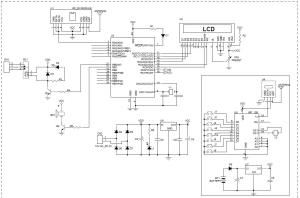RFiD Based Door Access Control
RFiD Based Door Access Control
SYNOPSIS
The concept of access control is brought about using a card, a corresponding card reader and a control panel interfaced with the server. The card is a proximity card with a unique identification number integrated in it. The reader reads the data and sends it to the control panel, which is the micro controller. This controller checks the validity of the data with the server, which bears the database. The server is loaded with the details about the employee for that number.
The control panel checks whether he/she is allowed to enter the particular door or not. If the employee is authentic, then he/she is allowed access in the particular entrance.
The employees can be permitted in a given entrance as per his/her designation. The access control is employed at this point. When a person of a particular designation is not supposed to be allowed in a given entrance.
CIRUIT DIAGRAM
Radio frequency (RF) refers to electromagnetic waves that have a wavelength suited for use in radio communication. Radio waves are classified by their frequencies, which are expressed in kilohertz, megahertz, or gigahertz. Radio frequencies range from very low frequency (VLF), which has a range of 10 to 30 kHz, to extremely high frequency (EHF), which has a range of 30 to 300 GHz.
RFID is a flexible technology that is convenient, easy to use, and well suited for automatic operation. It combines advantages not available with other identification technologies. RFID can be supplied as read-only or read / write, does not require contact or line-of-sight to operate, can function under a variety of environmental conditions, and provides a high level of data integrity. In addition, because the technology is difficult to counterfeit, RFID provides a high level of security.
RFID is similar in concept to bar coding. Bar code systems use a reader and coded labels that are attached to an item, whereas RFID uses a reader and special RFID devices that are attached to an item. Bar code uses optical signals to transfer information from the label to the reader; RFID uses RF signals to transfer information from the RFID device to the reader.
Radio waves transfer data between an item to which an RFID device is attached and an RFID reader. The device can contain data about the item, such as what the item is, what time the device travelled through a certain zone, perhaps even a parameter such as temperature. RFID devices, such as a tag or label, can be attached to virtually anything – from a vehicle to a pallet of merchandise.
RFID technology uses frequencies within the range of 50 kHz to 2.5 GHz. An RFID system typically includes the following components:
• An RFID device (transponder or tag) that contains data about an item
• An antenna used to transmit the RF signals between the reader and the RFID device
• An RF transceiver that generates the RF signals
• A reader that receives RF transmissions from an RFID device and passes the data to a host system for processing



Its a very good engineering topic. Access control is, in reality, an everyday phenomenon. The possession of access control is of prime importance when persons seek to secure important, confidential, or sensitive information and equipment.
ReplyDelete